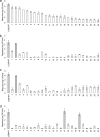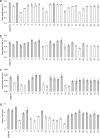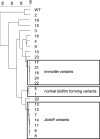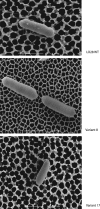Population diversity of Listeria monocytogenes LO28: phenotypic and genotypic characterization of variants resistant to high hydrostatic pressure
- PMID: 20139309
- PMCID: PMC2849257
- DOI: 10.1128/AEM.02434-09
Population diversity of Listeria monocytogenes LO28: phenotypic and genotypic characterization of variants resistant to high hydrostatic pressure
Abstract
A comparative phenotype analysis of 24 Listeria monocytogenes LO28 stress-resistant variants obtained after high-pressure treatment was performed to assess their robustness and growth performance under a range of food-relevant conditions. In addition, genetic analysis was conducted to characterize the promoter regions and open reading frames of the class I and III transcriptional repressors CtsR and HrcA, which control production of specific sets of stress proteins. Analysis of stress survival capacity, motility, biofilm formation, and growth under various conditions showed all variants to be more resistant to pressure and heat than the wild type; however, differences among variants were observed in acid resistance, growth rate, motility, and biofilm-forming capacity. Genetic analysis revealed no variation in the genetic make-up of hrcA and its upstream region, but two variants had deletions in the upstream region of ctsR and seven variants had mutations in the ctsR gene itself. The results of the characterization were cluster analyzed to obtain insight into the diversity of variants. Ten unique variants and three clusters with specific features could be identified: one cluster consisting of seven variants having a mutation in the CtsR regulator gene, one cluster containing two variants with an aerobic biofilm formation capacity similar to that of the wild type, and a cluster composed of five immotile variants. The large population diversity of L. monocytogenes stress-resistant variants signifies the organism's genetic flexibility, which in turn may contribute to the survival and persistence of this human pathogen in food-processing environments.
Figures







Similar articles
-
Isolation of highly heat-resistant Listeria monocytogenes variants by use of a kinetic modeling-based sampling scheme.Appl Environ Microbiol. 2011 Apr;77(8):2617-24. doi: 10.1128/AEM.02617-10. Epub 2011 Feb 25. Appl Environ Microbiol. 2011. PMID: 21357432 Free PMC article.
-
Contingency locus in ctsR of Listeria monocytogenes Scott A: a strategy for occurrence of abundant piezotolerant isolates within clonal populations.Appl Environ Microbiol. 2005 Dec;71(12):8390-6. doi: 10.1128/AEM.71.12.8390-8396.2005. Appl Environ Microbiol. 2005. PMID: 16332826 Free PMC article.
-
The CtsR regulator of Listeria monocytogenes contains a variant glycine repeat region that affects piezotolerance, stress resistance, motility and virulence.Mol Microbiol. 2003 Sep;49(5):1227-38. doi: 10.1046/j.1365-2958.2003.03636.x. Mol Microbiol. 2003. PMID: 12940983
-
Impact of Pathogen Population Heterogeneity and Stress-Resistant Variants on Food Safety.Annu Rev Food Sci Technol. 2016;7:439-56. doi: 10.1146/annurev-food-041715-033128. Epub 2016 Jan 11. Annu Rev Food Sci Technol. 2016. PMID: 26772414 Review.
-
Molecular biology of surface colonization by Listeria monocytogenes: an additional facet of an opportunistic Gram-positive foodborne pathogen.Environ Microbiol. 2011 Apr;13(4):835-50. doi: 10.1111/j.1462-2920.2010.02378.x. Epub 2010 Nov 18. Environ Microbiol. 2011. PMID: 21087384 Review.
Cited by
-
Modeling and Validation of the Ecological Behavior of Wild-Type Listeria monocytogenes and Stress-Resistant Variants.Appl Environ Microbiol. 2016 Aug 15;82(17):5389-401. doi: 10.1128/AEM.00442-16. Print 2016 Sep 1. Appl Environ Microbiol. 2016. PMID: 27342563 Free PMC article.
-
Genomic characterization of the most barotolerant Listeria monocytogenes RO15 strain compared to reference strains used to evaluate food high pressure processing.BMC Genomics. 2020 Jul 2;21(1):455. doi: 10.1186/s12864-020-06819-0. BMC Genomics. 2020. PMID: 32615922 Free PMC article.
-
High-pressure processing-induced transcriptome response during recovery of Listeria monocytogenes.BMC Genomics. 2021 Feb 12;22(1):117. doi: 10.1186/s12864-021-07407-6. BMC Genomics. 2021. PMID: 33579201 Free PMC article.
-
Response and adaptation of the transcriptional heat shock response to pressure.Front Microbiol. 2024 Nov 18;15:1470617. doi: 10.3389/fmicb.2024.1470617. eCollection 2024. Front Microbiol. 2024. PMID: 39624728 Free PMC article.
-
Effects of high hydrostatic pressure on bacterial growth on human ossicles explanted from cholesteatoma patients.PLoS One. 2012;7(1):e30150. doi: 10.1371/journal.pone.0030150. Epub 2012 Jan 23. PLoS One. 2012. PMID: 22291908 Free PMC article.
References
-
- Cheftel, J. C. 1995. Review: high-pressure, microbial inactivation and food preservation. Food Sci. Technol. Int. 1:75-90.
-
- Chen, H. 2007. Use of linear, Weibull, and log-logistic functions to model pressure inactivation of seven foodborne pathogens in milk. Food Microbiol. 24:197-204. - PubMed
-
- Chen, H., H. Neetoo, M. Ye, and R. D. Joerger. 2009. Differences in pressure tolerance of Listeria monocytogenes strains are not correlated with other stress tolerances and are not based on differences in CtsR. Food Microbiol. 26:404-408. - PubMed
-
- Considine, K. M., A. L. Kelly, G. F. Fitzgerald, C. Hill, and R. D. Sleator. 2008. High-pressure processing: effects on microbial food safety and food quality. FEMS Microbiol. Lett. 281:1-9. - PubMed
MeSH terms
Substances
LinkOut - more resources
Full Text Sources

